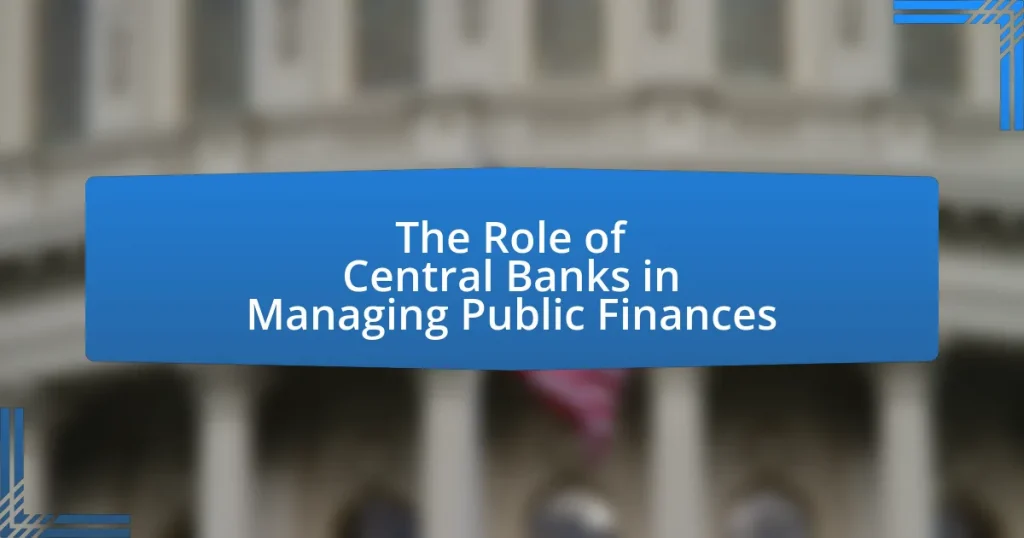Central banks are pivotal institutions responsible for managing public finances through the implementation of monetary policy, regulation of the banking system, and maintenance of financial stability. This article explores the various roles central banks play, including influencing national economies via interest rate adjustments, managing government debt, and ensuring currency stability. It also examines the tools central banks utilize, such as open market operations and quantitative easing, to impact inflation and employment levels. Furthermore, the article discusses the challenges central banks face, including political pressures and globalization, and their strategies for coordinating with government fiscal policies to promote economic growth and maintain public confidence in the financial system.

What is the Role of Central Banks in Managing Public Finances?
Central banks play a crucial role in managing public finances by implementing monetary policy, regulating the banking system, and ensuring financial stability. They influence interest rates and control money supply, which directly affects inflation and economic growth. For instance, during economic downturns, central banks may lower interest rates to stimulate borrowing and spending, thereby supporting public finances. Additionally, central banks oversee the issuance of government debt and manage foreign exchange reserves, which are essential for maintaining liquidity and confidence in the financial system. Their actions are supported by historical data, such as the Federal Reserve’s response to the 2008 financial crisis, where aggressive monetary easing helped stabilize the economy and public finances.
How do central banks influence national economies?
Central banks influence national economies primarily through monetary policy, which involves managing interest rates and controlling money supply. By adjusting interest rates, central banks can either stimulate economic growth by making borrowing cheaper or curb inflation by making borrowing more expensive. For example, during the 2008 financial crisis, the Federal Reserve lowered interest rates to near zero to encourage spending and investment, which helped stabilize the economy. Additionally, central banks implement quantitative easing, purchasing government securities to inject liquidity into the economy, further influencing economic activity. These actions directly impact inflation rates, employment levels, and overall economic stability, demonstrating the critical role central banks play in shaping national economies.
What tools do central banks use to manage public finances?
Central banks use various tools to manage public finances, including monetary policy, interest rate adjustments, and open market operations. Monetary policy involves controlling the money supply to influence economic activity, while interest rate adjustments can stimulate or cool down the economy by affecting borrowing costs. Open market operations, which entail buying or selling government securities, help regulate liquidity in the financial system. These tools are essential for maintaining economic stability and achieving objectives such as inflation control and employment levels. For instance, the Federal Reserve in the United States employs these methods to respond to economic fluctuations, demonstrating their effectiveness in managing public finances.
How do these tools impact inflation and employment?
Central banks use monetary policy tools, such as interest rate adjustments and quantitative easing, to influence inflation and employment levels. Lowering interest rates typically stimulates borrowing and spending, which can lead to increased demand for goods and services, thereby reducing unemployment. For instance, during the 2008 financial crisis, the Federal Reserve lowered rates to near zero, which contributed to a gradual decrease in unemployment from a peak of 10% in October 2009 to around 4% by 2018. Conversely, raising interest rates can help control inflation by making borrowing more expensive, which can slow down economic activity and potentially increase unemployment. In 2022, the Federal Reserve raised rates to combat rising inflation, which had reached a 40-year high of 9.1% in June. This illustrates how central banks’ tools directly impact inflation and employment through their influence on economic activity.
Why are central banks crucial for financial stability?
Central banks are crucial for financial stability because they regulate monetary policy, manage inflation, and act as lenders of last resort. By controlling interest rates and money supply, central banks influence economic activity and maintain price stability, which is essential for fostering a stable financial environment. For instance, during the 2008 financial crisis, central banks implemented quantitative easing and lowered interest rates to stabilize financial markets and restore confidence. This intervention helped prevent a deeper recession and demonstrated the central bank’s role in mitigating systemic risks.
What measures do central banks take to prevent financial crises?
Central banks implement several measures to prevent financial crises, including monetary policy adjustments, regulatory oversight, and liquidity support. By adjusting interest rates, central banks influence borrowing and spending, which can stabilize the economy during downturns. Regulatory oversight involves monitoring financial institutions to ensure they maintain adequate capital reserves and adhere to risk management practices, thereby reducing systemic risk. Additionally, central banks provide liquidity support through mechanisms like emergency lending facilities, which help stabilize financial markets during periods of stress. Historical examples include the Federal Reserve’s actions during the 2008 financial crisis, where it lowered interest rates and implemented quantitative easing to support the economy.
How do central banks maintain public confidence in the financial system?
Central banks maintain public confidence in the financial system by ensuring monetary stability, transparency, and effective communication. They achieve monetary stability through the implementation of policies that control inflation and stabilize currency value, which fosters trust among the public. For instance, the Federal Reserve targets a 2% inflation rate, which has historically contributed to economic stability and public confidence.
Additionally, central banks promote transparency by providing regular updates on economic conditions and policy decisions, which helps the public understand their actions and intentions. The European Central Bank, for example, publishes detailed reports and holds press conferences to clarify its monetary policy stance.
Effective communication further reinforces confidence, as central banks articulate their goals and strategies clearly, allowing the public to anticipate and react to economic changes. This proactive approach has been shown to reduce uncertainty and enhance trust in the financial system.
What challenges do central banks face in managing public finances?
Central banks face significant challenges in managing public finances, primarily due to the need to balance inflation control with economic growth. This dual mandate often leads to conflicting policy decisions, as measures to curb inflation, such as raising interest rates, can stifle economic activity. Additionally, central banks must navigate the complexities of fiscal policy coordination with governments, which can be hindered by political considerations and varying economic priorities. For instance, during economic downturns, central banks may be pressured to implement expansionary monetary policies, even when inflationary risks are present, complicating their ability to maintain price stability. Furthermore, global economic interdependencies can impact domestic financial stability, as external shocks may necessitate rapid policy adjustments that challenge existing frameworks.
How do political pressures affect central bank operations?
Political pressures can significantly influence central bank operations by impacting their decision-making processes and policy implementations. For instance, when governments exert pressure for lower interest rates to stimulate economic growth, central banks may face challenges in maintaining their independence and credibility. Historical examples include the Federal Reserve’s actions during the 2008 financial crisis, where political expectations for aggressive monetary easing led to debates about the central bank’s autonomy. Additionally, central banks may alter their communication strategies to align with political narratives, which can affect market perceptions and economic stability. Such dynamics illustrate the complex interplay between political environments and central banking functions, highlighting the necessity for central banks to navigate these pressures while striving to fulfill their mandates.
What role does globalization play in central bank decision-making?
Globalization significantly influences central bank decision-making by integrating economies and increasing interdependence among nations. Central banks must consider global economic conditions, such as international trade dynamics, capital flows, and foreign exchange rates, which directly impact domestic monetary policy. For instance, the 2008 financial crisis highlighted how interconnected financial systems can lead to rapid contagion, prompting central banks to adopt coordinated policy responses. Additionally, globalization affects inflation rates and employment levels, compelling central banks to adjust interest rates and implement quantitative easing to stabilize their economies in response to global economic shifts.
How do central banks coordinate with government fiscal policies?
Central banks coordinate with government fiscal policies primarily through monetary policy tools and communication strategies. Central banks, such as the Federal Reserve in the United States, adjust interest rates and implement quantitative easing to influence economic conditions, which can complement government spending and taxation decisions. For instance, during economic downturns, a central bank may lower interest rates to stimulate borrowing and investment, thereby supporting fiscal measures aimed at boosting economic activity. This coordination is often formalized through regular meetings and reports, such as the U.S. Federal Open Market Committee’s assessments of economic conditions, which consider fiscal policy impacts. Historical examples include the response to the 2008 financial crisis, where central banks and governments worked together to stabilize economies through coordinated monetary and fiscal actions.
What is the relationship between central banks and commercial banks?
Central banks and commercial banks have a symbiotic relationship where central banks regulate and oversee the monetary system, while commercial banks provide financial services to the public. Central banks, such as the Federal Reserve in the United States, set interest rates and control money supply, which directly influences the lending and borrowing activities of commercial banks. For instance, when a central bank lowers interest rates, it encourages commercial banks to lend more, stimulating economic growth. Additionally, central banks act as a lender of last resort to commercial banks during financial crises, ensuring liquidity in the banking system. This relationship is crucial for maintaining financial stability and implementing monetary policy effectively.

What are the specific functions of central banks in public finance management?
Central banks play a crucial role in public finance management through several specific functions. These functions include formulating and implementing monetary policy, managing foreign exchange and gold reserves, overseeing the banking system, and acting as a fiscal agent for the government.
By controlling interest rates and influencing money supply, central banks aim to achieve economic stability and growth, which directly impacts public finance. For instance, the Federal Reserve in the United States adjusts interest rates to manage inflation and unemployment, thereby influencing government borrowing costs and fiscal policy effectiveness.
Additionally, central banks ensure the stability of the financial system by supervising and regulating banks, which helps maintain public confidence in financial institutions. This regulatory oversight is essential for preventing financial crises that could adversely affect public finances.
Moreover, central banks manage the government’s accounts and facilitate its transactions, ensuring efficient cash flow management. This function is vital for maintaining liquidity in the economy and supporting government spending initiatives.
In summary, the specific functions of central banks in public finance management include monetary policy implementation, financial system oversight, and acting as the government’s fiscal agent, all of which contribute to economic stability and effective public finance management.
How do central banks implement monetary policy?
Central banks implement monetary policy primarily through the manipulation of interest rates and the control of money supply. By adjusting the benchmark interest rates, such as the federal funds rate in the United States, central banks influence borrowing costs, which in turn affects consumer spending and business investment. For instance, lowering interest rates typically stimulates economic activity by making loans cheaper, while raising rates can help curb inflation by slowing down spending. Additionally, central banks utilize open market operations, where they buy or sell government securities to increase or decrease the amount of money circulating in the economy. This method directly impacts liquidity and can stabilize or stimulate economic growth. Historical examples include the Federal Reserve’s actions during the 2008 financial crisis, where aggressive rate cuts and quantitative easing were employed to support the economy.
What are the different types of monetary policy tools?
The different types of monetary policy tools include open market operations, the discount rate, and reserve requirements. Open market operations involve the buying and selling of government securities to influence the money supply; for instance, when a central bank purchases securities, it injects liquidity into the economy. The discount rate is the interest rate charged to commercial banks for short-term loans from the central bank, which can affect lending rates and overall economic activity. Reserve requirements dictate the minimum reserves each bank must hold against deposits, directly impacting the amount of money banks can lend. These tools are essential for central banks to manage inflation, control employment levels, and stabilize the currency.
How does monetary policy affect government borrowing?
Monetary policy affects government borrowing primarily through interest rates and the availability of credit. When a central bank implements an expansionary monetary policy, it typically lowers interest rates, making borrowing cheaper for the government. For instance, during the 2008 financial crisis, the Federal Reserve reduced interest rates to near zero, which allowed the U.S. government to issue bonds at lower costs, facilitating increased borrowing to stimulate the economy. Conversely, contractionary monetary policy raises interest rates, which can lead to higher borrowing costs for the government, potentially reducing the amount of debt it can afford to take on. This relationship is evident in the context of the U.S. Treasury yields, which often rise in response to anticipated interest rate hikes by the Federal Reserve, indicating a direct link between monetary policy decisions and government borrowing costs.
What role do central banks play in currency stability?
Central banks play a crucial role in maintaining currency stability by implementing monetary policy, regulating money supply, and managing interest rates. These institutions aim to control inflation and stabilize the currency’s value against other currencies, which is essential for economic confidence and growth. For instance, the Federal Reserve in the United States adjusts interest rates to influence economic activity and inflation, thereby impacting the stability of the U.S. dollar. Historical data shows that countries with active central bank interventions, such as Japan and Switzerland, have experienced more stable currencies compared to those with less intervention.
How do central banks manage exchange rates?
Central banks manage exchange rates primarily through monetary policy interventions and foreign exchange market operations. They may adjust interest rates to influence capital flows and currency value, as higher interest rates typically attract foreign investment, strengthening the currency. Additionally, central banks can directly buy or sell their own currency in the foreign exchange market to stabilize or influence its value. For instance, during the 1992 Black Wednesday crisis, the Bank of England intervened by selling billions of pounds to defend its currency, ultimately leading to its exit from the European Exchange Rate Mechanism. These actions demonstrate how central banks actively engage in managing exchange rates to achieve economic stability and control inflation.
What impact does currency stability have on public finances?
Currency stability significantly enhances public finances by promoting predictable revenue streams and reducing the cost of borrowing. When a currency is stable, it fosters investor confidence, leading to increased foreign direct investment and economic growth, which in turn boosts tax revenues. For instance, countries with stable currencies often experience lower inflation rates, which helps maintain the purchasing power of government revenues. According to the International Monetary Fund, stable currencies can lead to lower interest rates, as seen in nations like Switzerland, where consistent currency value has resulted in favorable borrowing conditions for the government. This stability ultimately allows for better planning and execution of public spending, ensuring that funds are allocated efficiently to essential services and infrastructure.
How do central banks contribute to economic growth?
Central banks contribute to economic growth by implementing monetary policy that influences interest rates and money supply. By lowering interest rates, central banks encourage borrowing and investment, which stimulates economic activity. For example, during the 2008 financial crisis, the Federal Reserve reduced the federal funds rate to near zero, which helped to revive the economy by making loans cheaper for consumers and businesses. Additionally, central banks engage in quantitative easing, purchasing government securities to inject liquidity into the economy, further supporting growth. This approach has been shown to increase asset prices and consumer confidence, leading to higher spending and investment.
What strategies do central banks use to stimulate economic activity?
Central banks use several strategies to stimulate economic activity, primarily through monetary policy tools. These tools include lowering interest rates, which reduces the cost of borrowing and encourages spending and investment; implementing quantitative easing, which involves purchasing government securities to increase money supply and lower long-term interest rates; and providing forward guidance, which communicates future policy intentions to influence economic expectations. For instance, during the 2008 financial crisis, the Federal Reserve lowered the federal funds rate to near zero and initiated quantitative easing, resulting in increased liquidity in the economy and a gradual recovery in economic activity.
How does economic growth influence public revenue?
Economic growth increases public revenue primarily through higher tax collections. As the economy expands, businesses generate more income, leading to increased corporate tax revenues, while individuals earn higher wages, resulting in greater income tax contributions. For instance, during periods of robust economic growth, such as the post-2008 recovery in the United States, federal tax revenues rose significantly, reaching over $3 trillion in 2019, largely due to increased economic activity and employment rates. This correlation between economic growth and public revenue is supported by historical data, demonstrating that GDP growth directly enhances the tax base, allowing governments to fund public services and investments more effectively.

What are the implications of central bank policies on public finance?
Central bank policies significantly influence public finance by affecting interest rates, inflation, and government borrowing costs. For instance, when a central bank lowers interest rates, it reduces the cost of borrowing for governments, enabling them to finance public projects more affordably. This can lead to increased public spending, which may stimulate economic growth. Conversely, if a central bank raises interest rates to combat inflation, it can increase government borrowing costs, potentially leading to reduced public spending and tighter fiscal policies. Historical examples include the Federal Reserve’s actions during the 2008 financial crisis, where low interest rates facilitated government stimulus measures, impacting public finance positively. Thus, central bank policies play a crucial role in shaping the fiscal landscape by directly influencing government financial strategies and economic conditions.
How do central bank decisions affect government budgets?
Central bank decisions significantly impact government budgets by influencing interest rates and inflation, which in turn affect government borrowing costs and revenue. For instance, when a central bank lowers interest rates, it reduces the cost of borrowing for the government, allowing for increased spending on public services and infrastructure without raising taxes. Conversely, if a central bank raises interest rates to combat inflation, the government may face higher borrowing costs, which can lead to budget deficits or reduced public spending. Historical data shows that during the 2008 financial crisis, central banks implemented low interest rates, enabling governments to finance stimulus packages that supported economic recovery. Thus, central bank policies directly shape the fiscal landscape by altering the financial conditions under which governments operate.
What is the impact of interest rates on public spending?
Interest rates significantly influence public spending by affecting the cost of borrowing for governments. When interest rates rise, the cost of servicing existing debt increases, which can lead to reduced public spending as governments allocate more resources to interest payments rather than public services or infrastructure projects. Conversely, lower interest rates decrease borrowing costs, enabling governments to invest more in public spending initiatives. For instance, during periods of low interest rates, such as after the 2008 financial crisis, many governments increased spending to stimulate economic growth, as evidenced by the expansionary fiscal policies adopted by various countries. This relationship underscores the critical role that central banks play in managing interest rates to influence public finance decisions.
How do central banks influence tax policies through their actions?
Central banks influence tax policies primarily through their monetary policy actions, which affect economic conditions and government revenue. For instance, when a central bank adjusts interest rates, it impacts borrowing costs and consumer spending, subsequently influencing tax revenues. Lower interest rates can stimulate economic growth, leading to increased tax collections from income and sales taxes. Conversely, higher rates may slow down the economy, reducing tax revenues.
Additionally, central banks can influence inflation rates through their policies, which in turn affects tax policy decisions. For example, if inflation rises, governments may adjust tax brackets or rates to maintain purchasing power, reflecting the central bank’s monetary stance. Historical evidence shows that during periods of high inflation, such as in the 1970s, governments often revised tax policies to address the economic challenges posed by central bank actions. Thus, the interplay between central banks’ monetary policies and tax policies is significant in shaping public finances.
What are the long-term effects of central bank policies on public debt?
Central bank policies can significantly influence public debt over the long term by affecting interest rates, inflation, and government borrowing. For instance, when central banks implement low-interest-rate policies, it reduces the cost of borrowing for governments, which can lead to increased public debt levels as governments may take advantage of cheaper financing to fund spending initiatives. Additionally, quantitative easing, a common central bank policy, can lead to higher inflation expectations, which may erode the real value of existing debt but can also create a dependency on continued low rates for debt sustainability. Historical examples, such as the post-2008 financial crisis period, illustrate that prolonged low rates and expansive monetary policies resulted in substantial increases in public debt across many advanced economies, with the U.S. national debt rising from approximately $10 trillion in 2008 to over $30 trillion by 2021. This demonstrates that central bank policies can have lasting impacts on public debt dynamics, shaping fiscal space and influencing future economic stability.
How do central banks manage the risks associated with public debt?
Central banks manage the risks associated with public debt primarily through monetary policy and financial stability measures. They utilize interest rate adjustments to influence borrowing costs, thereby impacting the level of public debt. For instance, by lowering interest rates, central banks can reduce the cost of servicing existing debt, which helps mitigate default risks. Additionally, central banks conduct stress tests and monitor economic indicators to assess the sustainability of public debt levels. According to the International Monetary Fund, effective debt management strategies, including the issuance of bonds with varying maturities, further enhance the resilience of public finances against economic shocks.
What strategies can central banks employ to ensure sustainable debt levels?
Central banks can employ several strategies to ensure sustainable debt levels, including implementing effective monetary policy, maintaining transparency, and fostering economic growth. Effective monetary policy involves adjusting interest rates to influence borrowing and spending, which can help manage inflation and stabilize debt levels. For instance, during periods of high debt, central banks may raise interest rates to discourage excessive borrowing. Transparency in communication regarding monetary policy decisions builds public trust and helps manage expectations, which can stabilize financial markets. Additionally, fostering economic growth through supportive policies can increase government revenues, making it easier to manage and repay debt. Historical examples, such as the Federal Reserve’s actions during the 2008 financial crisis, demonstrate how proactive monetary policy can stabilize debt levels by promoting economic recovery.
What best practices should central banks follow in managing public finances?
Central banks should prioritize transparency, accountability, and effective communication in managing public finances. Transparency ensures that stakeholders understand monetary policy decisions and their implications, which fosters trust and stability in the financial system. Accountability involves adhering to established frameworks and being answerable for policy outcomes, which enhances credibility. Effective communication helps in managing public expectations and aligning market behavior with policy objectives. For instance, the European Central Bank’s commitment to clear communication strategies has been shown to influence market reactions positively, as evidenced by studies indicating that well-articulated guidance can lead to more predictable financial markets.


